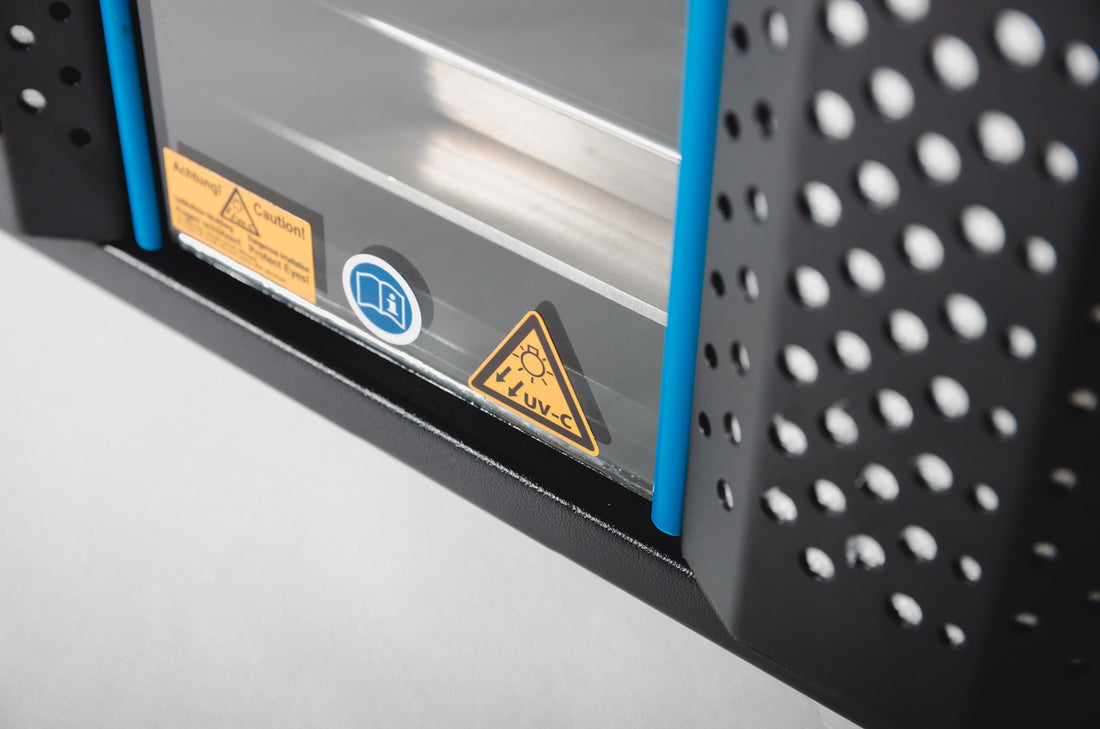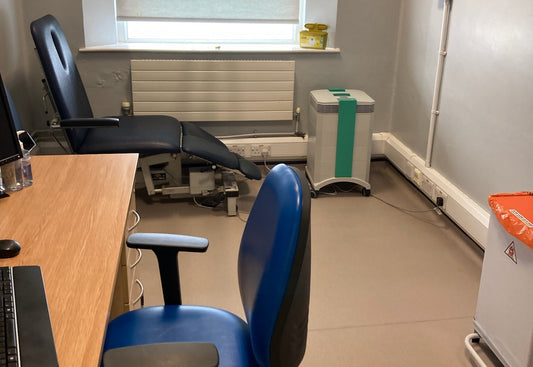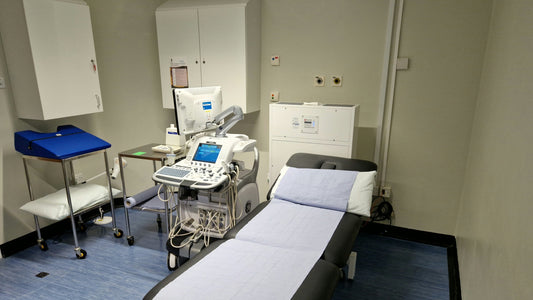Introduction
Short-wave ultraviolet energy (UVC) - at a certain wavelength, distance, and exposure time - has been shown in laboratory environments to disrupt the DNA of microorganisms and thus to be able to inactivate viral, bacterial and fungal organisms. Most of the studies regarding UVC for germicidal irrigation have, however, focused on UVC’s ability to inactivate microorganisms on surfaces. Much less research has been done to confirm UVC’s ability to inactivate microorganisms that are airborne. In this post we will discuss some of the evidence regarding the use of UVC to a) inactivate airborne microorganism and b) if UVC technology is effective and beneficial to use in standalone air cleaners.
Background on UVC air cleaner technology
Ultraviolet radiation is optical radiation with a wavelength that is invisible to humans. It is differentiated into three stages: UVC with a wavelength of 200 to 280 nm, UVB with a wavelength of 280 to 315, and UVA with a wavelength of 315 to 400. The most effective UV wavelength for the inactivation of microorganisms is UVC at 253-265 nm.[1]
UVC light for germicidal irradiation is commonly produced by using low-pressure mercury vapor lamps. These UVC lamps bring about certain design requirements for the systems they are installed in. The wavelength and thus the effectiveness of a UVC lamp and the device itself can be influenced by a variety of factors, such as humidity levels, airflow rate, temperature, as well as level of contamination in the air that the lamp is exposed to. Relative humidity levels - for example - should be less than 60%. [2] Other factors, such as intermittent operation – i.e., turning a UVC lamp on and off – can also negatively impact the lamp’s ballast performance and overall life of the lamp. [3]
Not all microorganisms are impacted by UVC equally. Larger microorganisms, such as fungal spores, can be resistant to UVC. [4] A biofilm on microorganisms can also be protecting the microorganism from the UVC energy and thus might pass the lamp undamaged. The Coronavirus SARS-CoV-2, for example, is only 100 nm, but when it is exhaled, it is not completely exposed but is likely part of respiratory fluids that can contain salts, proteins, and surfactants. These respiratory fluids can cover and thus protect a significant number of viruses from the UV energy through a biofilm. [5]
Applications of UVC for surface treatment
Traditionally, UVC is used in HVAC systems to control microbial growth on filters and cooling coils, to help reduce pressure drop across the coils and improve heat exchanger efficiency. This then “eliminates one potential air contamination source that could degrade indoor air quality.” [6] But does UVC actually inactivate airborne microorganisms that travel through the HVAC system?
ASHRAE (The American Society of Heating, Refrigerating and Air-Conditioning Engineers) seems to suggest so. Where coil surface irradiance level can be effective at 1 yW/cm2, “air disinfection irradiance levels…may exceed 1000 yW/cm2.” [7] According to ASHRAE's Handbook for 'HVAC Systems and Equipment', the essential difference between surface decontamination and airborne inactivation of microorganisms is the exposure time. [8] Due to the speed the contamination travels through the system, “in-duct systems should be installed in a location that can provide a minimum of 0.25 s of UV exposure; otherwise, systems cost and power consumption will be excessive.” [9]
It is important to note that ASHRAE is of course only concerned with HVAC systems – not stand-alone air cleaners. Similarly, the supporting evidence that is supplied in their Handbook is in relation to the use of UVC in HVAC systems, not the use of UVC in standalone air cleaners. A ducted HVAC system, however, is very different from a standalone air cleaner. It would be a mistake to simply infer that because something seems to be effective in a ducted system it should just as well work in a standalone air cleaner.
Standalone UVC air cleaners
To make a significant reduction in contamination levels in a given room, a standalone air cleaner, with effective filtration, needs to move enough air through the unit to achieve several air changes per hour. If the airflow rate is high, however, contamination in the air - such as viruses and bacteria - travel through the air cleaner very fast, reducing the exposure time of the UVC light on the contamination to only a second or even a fraction of a second. Some manufacturers of UV air cleaners try to extend the exposure time by using multiple UVC lamps, or even banks of UVC lamps, and organise them in a variety of different configurations to maximise the exposure time of contamination to the UVC light. [10]
Nevertheless, even if we construct a UVC air cleaner with a very generous 40 cm inner diameter, a moderate 300 m3/h airflow rate, and a UVC-chamber height of 66 cm, exposure time will only be 1 second. If the numbers are changed to a more realistic and workable 20 cm diameter, a 500 m3/h airflow, and a 66 cm long UVC-chamber, the exposure time decreases to 0.13 seconds. A recent study evaluated UVC light and its effectiveness at a distance of a few cm from the targeted microorganism. In regard to exposure time, the study states:
at "3 cm distance... exposure of virus to UVC light resulted in partial inactivation at 1min with increasing efficiency up to 6min… No additional inactivation was observed from 6 to 10min. After 15 min the virus was completely inactivated to the limit of detection...” [11]
This leads us to the main question of this post, i.e.: what actual research studies have been done that show germicidal irradiation can effectively be done on airborne viral contamination? What evidence is there to show that UVC in an air cleaner provides any real benefit? Or more precisely - what benefit does UVC in an air cleaner provide that is not already provided if the air cleaner is fitted with proper HEPA filtration?
The Centers for Disease Control and Prevention (CDC) writes:
"The use of UV lamps and HEPA filtration in a single unit would not be expected to have any infection-control benefits not provided by use of the HEPA filter alone." [15]
In the “Air Cleaning Technologies - An Evidence-Based Analysis’” Ontario Health, the Crown agency of the Government of Ontario, writes:
“There is uncertainty in the benefits of using in-room air cleaners with combined UVGI lights and HEPA filtration over systems that use HEPA filtration alone.” [12]
Five years later, a study published in the American Journal of Infection Control called “Applications of ultraviolet germicidal irradiation disinfection in health care facilities: effective adjunct, but not stand-alone technology” writes:
“We conclude that although UVGI is microbiocidal, it is not "ready for prime time" as a primary intervention to kill or inactivate infectious microorganisms… More targeted and multiparameter studies are needed to evaluate the efficacy, safety, and incremental benefit of UVGI for mitigating reservoirs of microorganisms and ultimately preventing cross-transmission of pathogens that lead to health care-associated infections.” [13]
In February 2021, the Association for Aerosol Research writes in "On understanding the role of aerosol particles in SARS-CoV-2 infection":
"While viruses deposited on filters with the aid of UV radiation can thus be efficiently inactivated, it is currently unclear whether the findings can be transferred to airborne viruses.” [14]
UVC to inactivate viruses in an air cleaner
Some manufacturers acknowledge that their UVC air cleaner might not able to sterilise the air that goes through it but argue that the UVC lamp is needed to destroy microorganisms in the filters that collect them. The filter in the air cleaner is then what is cleaning the air and is reducing contamination in the room air, and the UVC lamp is supposed to make maintenance work such as a filter change safer, as it is supposed to irradiate viral contamination on the filter.
Proper leakage-free HEPA filtration traps and retains viruses effectively - as the test for EN1822 classification of H12 and H13 filter media shows. Furthermore, HEPA air cleaners designed for infection control environments often offer antimicrobial pre-filters and HEPA filters. [16] The antimicrobial filter surface act as a contact bactericide and thus provides an additional barrier against airborne microorganisms that are captured by the filter. One of the active component that is used in some air cleaners for infection control has been used for decades and is incorporated in a variety of products, such as liquid hard surface disinfectants, antimicrobial hand soaps, wound dressings and in disinfectants for medical device sterilisation. PHMB is active against a broad spectrum of microorganisms, including antibiotic resistant bacteria. Furthermore, viruses (including influenza) do not survive for more than a couple of hours on a surface such as a filter, as they require a host organism to survive and multiply. Heat or UV radiation is not needed to destroy a virus on a filter surface.
But even if the purpose of the UVC lamp in an air cleaner is to "keep the filter clean", it is difficult to see how a UVC light in an air cleaner could shine on all parts of a pleated filter, such as a proper HEPA filter. A professional air cleaner might have a pre-filter and main HEPA filter with a surface area of 7m2 each. [17] Any area that is not directly exposed to the UVC light - which could be a significant amount in a pleated filter like this - will be unaffected and thus viral contamination not inactivated.
Health concerns regarding UVC air cleaners
Exposure to UVC light that is strong enough to be considered of ‘germicidal wavelength’ is carcinogenic. [17] Temporary and permanent damage to the eyesight and inflammation of the cornea is a risk, as direct exposure to UVC can damage the retina. As UVC is invisible to humans, risk to exposure is not always apparent. UV light at a wavelength of 185 nm generates ozone. This happens when the UVV energy reacts with oxygen. For this reason UVC lamps are often made out of doped quartz glass, to bock the ozone-producing 185 nm wavelength.
“The US Environmental Protection Agency designated 0.05 parts per million (ppm) of ozone to be a safe level. Lamps designed to release UVC and higher frequencies are doped so that any UV light below 254 nm wavelengths will not be released, to minimise ozone production. A full-spectrum lamp will release all UV wavelengths and produce ozone when UV-C hits oxygen (O2) molecules.” [21]
Ozone is a concern, because if ozone builds up in an environment and significant levels of ozone are reached, ozone can break down natural tissue, such as lung tissue, posing a particular risk to people with respiratory issues.
Besides pointing out that the evidence for the effectiveness of UV radiation in its ability to inactivate airborne viruses is lacking, the Association for Aerosol Research writes in 2021 about UVC air cleaners:
“The method also harbours potential risks: UV rays cause damage to human skin when irradiated directly. In addition, UV radiation can lead to the formation of ozone in the room air. Accordingly, such methods should not be used if there are people in the room who could be exposed to UV radiation or ozone." [18]
Subsequently, on 11th of June 2021, Health Canada regulated UV and Ozone Devices, and writes:
"Ultraviolet (UV) radiation-emitting and ozone-generating devices such as lights and wands have become increasingly available for sale since the COVID-19 pandemic. These devices are marketed to kill bacteria and viruses, including SARS-CoV-2, the virus that causes COVID-19….Health Canada has not received enough evidence to confirm that these devices are safe for users and the public, or that they are effective. These devices have not been evaluated against the requirements of the Pest Control Products Act. Therefore, at present, these devices may pose a serious health and safety risk." [19]
The concern regarding UVC lamps and ozone production is then that UV lamps - if not maintained properly - can change in wavelength over time and thus produce ozone as an unwanted by-product. The University of Michigan department of Occupational Safety and Environmental Health (OSEH) writes:
„(OSEH) has adopted the position of the NSF, NIH, CDC and the American Biological Safety Association (ABSA) in regard to the use of UV lamps ... UV lamps are neither recommended nor required in biological safety cabinets. The use of Ultraviolet germicidal irradiation (UVGI) ... lends little to product sterility or personal safety in research settings, and has caused numerous hazardous UV exposures to employees while creating a hazardous waste disposal problem from the mercury in the bulbs. ... UV bulbs typically start to degrade and fail 6 months after installation. Without measuring the UV output there is no indication that the bulb is failing.“ [20]
UVC air cleaner and electricity usage
In addition to concerns about effectiveness as well as health and safety, there is also the concern regarding unnecessary cost. Ontario Health states:
“There is an increase in the burden of cost including capital costs (cost of the device), operating costs (electricity usage), and maintenance costs (cleaning and replacement of UVGI lights) to using an in-room air cleaner with combined UVGI and HEPA technology compared with those with HEPA alone.” [22]
A common 'UV-C air sterilisation products' that is offered as UVC air cleaners in the UK uses 288 Watt to provide a maximum airflow rate of 360 m3/h. An individually tested, certified and guaranteed HEPA air cleaner with antimicrobial H13 filters only uses 105 Watt to produce 370 m3/h, and can provide a maximum airflow of 530 m3/h at 135 Watt. [23]
Why have a UVC light in an air cleaner if it is most likely ineffective?
The likely reason why some manufacturers include UVC lamps in their air cleaners that are already fitted with proper HEPA filtration is, that they are more concerned with creating a compelling marketing and sales message, rather than creating a better air cleaner. [24] Integrating different filtration technologies into an air cleaner is then done to ‘tick all the boxes’ and give the impression that an air cleaner that uses several 'filtration technologies' will be superior in performance to an air cleaner that 'just' uses HEPA filtration.
Some of the manufacturers we have spoken with did not actually believe that their UVC air cleaner can increase the air purifier’s overall efficiency by including a UVC light. Nor were they able to guarantee that the viruses will be inactivated reliably by using UVC lamps in their air cleaner. The real reason that the UVC lamps are included in the air cleaner seems to be that it provides a revenue driver through the replacement of UV lamps. For safety reasons, UV lights are suggested to be changed regularly. As most UVC lamps are relatively inexpensive to manufacture, they can provide significant profit margins.
Thus, the evidence regarding the use of UVC to inactivate airborne microorganism is far from obvious. To us it seems that adding UVC in standalone air cleaners does not add any benefits or improvements in performance that a proper HEPA filter does not already provide. The drawbacks we see, however, are obvious – a possible health and safety risks, additional cost, and possibly a false sense of security.
[1] ASHRAE Handbook 62.1, ULTRAVIOLET AIR AND SURFACE TREATMENT
[2] ASHRAE Handbook 62.7, ULTRAVIOLET AIR AND SURFACE TREATMENT
[3] ASHRAE Handbook 62.7, ULTRAVIOLET AIR AND SURFACE TREATMENT
[4] ASHRAE Handbook 62.9, ULTRAVIOLET AIR AND SURFACE TREATMENT
[5] Prof. Catherine Noakes- Institute of Mechanical Engineers, COVID-19 INFECTION CONTROL EXPERT WEBINAR
[6] ASHRAE Handbook 62.1, ULTRAVIOLET AIR AND SURFACE TREATMENT
[7] ASHRAE Handbook 62.8, ULTRAVIOLET AIR AND SURFACE TREATMENT
[8] ASHRAE Handbook 62.5, ULTRAVIOLET AIR AND SURFACE TREATMENT
[9] ASHRAE Handbook 62.8, ULTRAVIOLET AIR AND SURFACE TREATMENT
[10] https://en.wikipedia.org/wiki/Ultraviolet_germicidal_irradiation
[11] Darnell, ME, Subbarao K, Feinstone SM et al. (2004). Inactivation of the coronavirus that induces severe acute respiratory syndrome SARS-CoV J. Virol. Methods,121: pp. 85-91. At: https://www.researchgate.net/publication/8362562_Inactivation_of_the_coronavirus_that_induces_se vere_acute_respiratory_syndrome_SARS-CoV
[12] Ont Health Technol Assess Ser. 2005; 5(17): 1–52. Published online 2005 Nov 1.
[13] Am J Infect Control. 2010 Jun;38 Farhad Memarzadeh 1, Russell N Olmsted, Judene M Bartley
[14] https://ae00780f-bbdd-47b2-aa10-e1dc2cdeb6dd.filesusr.com/ugd/fab12b_d8d88393f90240cdbea63c88c09887ef.pdf
[15] https://www.cdc.gov/mmwr//preview/mmwrhtml/00035909.htm
[16] https://commercialairfiltration.co.uk/collections/iqair-cleanroom-series
[17] ASHRAE Handbook 62.12, ULTRAVIOLET AIR AND SURFACE TREATMENT
[17] https://commercialairfiltration.co.uk/products/iqair-cleanroom-h13
[18] The Association for Aerosol Research, "On understanding the role of aerosol particles in SARS-CoV-2 infection" February 2021.
[19] https://www.canada.ca/en/health-canada/services/drugs-health-products/covid19-industry/disinfectanst-sanitizers-cleaners-soaps/ultra-violet-radiation-emitting-ozone-generating-devices.html
[20] https://ehs.umich.edu/research-clinical/
[21] US Center for Disease Control and Prevention (CDC)
[22] Ont Health Technol Assess Ser. 2005; 5(17): 1–52. Published online 2005 Nov 1.
[23] https://commercialairfiltration.co.uk/products/iqair-cleanroom-h13
[23] Frank Hammes, The Seven Sins of Air Purifier Manufacturers, Indoor Environment Communications.




